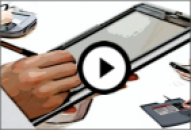Using stylus-based displays or screens at the Point Of Sale offers many advantages such as customers being able to read and respond to documents on the display, the capture of electronic signatures and use of the display for advertising. However this requires specialised software to make best use of all the advantages such displays can potentially offer.
Most e-signing market alternatives cannot offer 'kiosk' options
With many traditional systems, there are inherent issues of size and useability by both customer and service agent that must be taken into account:
- Due to their relatively large display sizes (typically 10 inch or more) compared to traditional signing pads, the main advantages of stylus-based displays are to allow customers to comfortably read whole documents and to show images or videos for advertising/marketing purposes. Common electronic signatures pads not only have a much smaller display but also the response time between e-signature pads and a PC is much slower. Therefore it is nearly impossible to show high resolution pictures or advertising videos on such pads.
- On the other hand, by using a second PC screen, the problem will occur that the screen will be recognised by the operating system as a second screen which is using a stylus as an additional input device. In a typical POS scenario whereby the second screen is used to capture a customer’s signature, every time the customer touches the screen with the stylus, the mouse focus is shifted to the second screen. It is furthermore very complex and training intensive to display documents on two screens. This means a multi-factor productivity loss without xyzmo software.
xyzmo SIGNificant software can
The above mentioned problems can be solved with the SIGNificant 'Kiosk' modus. Simultaneous customer and employee input interactions will no longer interfere. In addition, a separate “preview” window is active on the employee screen, displaying what is happening on the second screen, to allow the employee to assist the customer when or if required. Especially if there is a bigger distance between the two screens, this functionality is extremely helpful. If there are no active documents waiting to be signed by the customer, the second screen (such as a Wacom DTU-1031 tablet) automatically switches into “advertising mode” and displays pre-defined advertising slides or video clips. The kiosk mode is a natural software partner to a 10 inch (or larger) tablet from leading specialist manufacturers.
Accessibility Controls
The player supports TAB to change the controls.
Update Required<br/>To play the media you will need to either update your browser to a recent version or update your <a href='http://get.adobe.com/flashplayer/' target='_blank'>Flash plugin</a>.
Short silent video demonstrating Advertising and e-Signature Capturing at the POS with Wacom DTU-1031 tablet
| 

 Connect with us on Linkedin
Connect with us on Linkedin 


 Connect with us on Linkedin
Connect with us on Linkedin 

![]()
![]()
![]()